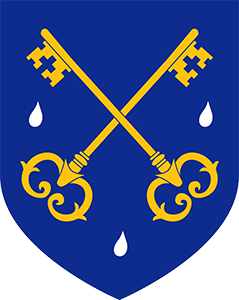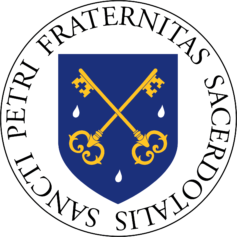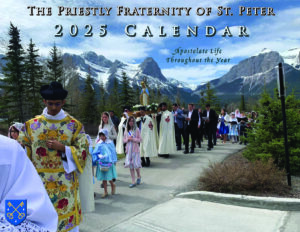Frodo, Gandalf, Aragorn…and Jesus Christ
by Fr. Daniel Alloy, FSSP
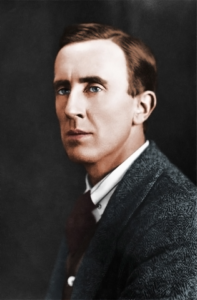
J.R.R. Tolkien hated when people drew shallow religious allegories from his works. Tolkien’s stories are about the heroes, villains, and “honest folk” you meet on your journey from cover to cover. He was a master-builder of myth, one who faithfully observed the laws of storytelling. Indeed, he himself reiterated said laws more eloquently than any of his forbears.1
They say that every word before the “but” does not matter, so I will cut to the chase. But…there is a three-fold allegory that I have long found compelling in the works of Tolkien. I humbly offer this little reflection to you, hoping that Mr. Tolkien is not scowling at me from whatever lofty mansion in Heaven he may occupy. I crave his indulgence, and yours. If this little article be tried and found wanting, let it be calmly set aside without worry or care.
So, here it goes.
There are three heroes in Tolkien’s magnum opus, The Lord of the Rings. There is Frodo, the Ring-bearer, who journeys with Sam even unto the fires of Mt. Doom. There is Gandalf, the wise guide of the Fellowship, the counselor of kings, the “man behind the curtain” for so much of the story, and the one who rises from the dead. (If this last bit was a spoiler for you, then you should stop reading this and start reading Tolkien.) And finally, there is Aragorn, the hidden king who reclaims the throne of his fathers.
Our Lord Jesus Christ fulfilled three offices during His earthly ministry. Christ is a priest, a prophet, and a king.2 Christ is the eternal High-Priest at the sacrifice of Calvary, and He remains the same High-Priest at every Mass. Christ is the prophet par excellence, the fulfillment of all who went before Him. And Christ solemnly confessed His kingship before Pontius Pilate.3
I believe there is a connection between Tolkien’s three heroes and Christ’s three offices. I believe Tolkien divided these three offices between his three heroes. Did Tolkien actually intend to do this? I plan to ask the man myself, provided St. Peter admits me through the pearly gates after my particular judgment. Believe me, this is high on my heavenly to-do list (right up there with checking for C.S. Lewis, and having a beer with St. Philip Neri).
Until then, assuming this alleged connection is not simply a feverish dream, or worse, a reckless affront to the legacy of the 20th century’s greatest author, what are the details? How does work? And why? Well, my dear reader, I am glad you asked.
Frodo – Christ the Priest

“For every high priest taken from among men, is ordained for men in the things that appertain to God, that he may offer up gifts and sacrifices for sins.”4 A priest lives to offer sacrifice for sin. A priest, therefore, lives on a plane set aside from men, wherein he stands as a mediator, offering sacrifices up to God, and drawing down blessings upon men. This separation is highlighted by the gift of celibacy, which gives a man the interior freedom to offer himself wholly to Christ for the Church. And yet, for all that, a priest remains a man and a sinner. “[The priest] can have compassion on them that are ignorant and that err: because he himself also is compassed with infirmity.”5
This is the life of Frodo in a nutshell. He freely accepts the burden of the Ring in order to save the Shire (and later, to save Middle-Earth). He continues to choose this sacrifice through cold, hunger, betrayal, loss, and almost certain death. He walks into the valley of death with a priestly understanding of the sacrifice’s cost, its worth, and its supreme importance.
And yet, Frodo is far from an immaculate hero. He makes bad choices. The Ring slowly corrupts him. In the end, he fails. It is only by “chance”, (really the inscrutable designs of Ilúvatar) that the Ring is finally destroyed. He is a hobbit encompassed by infirmity.
Consider this scene between Frodo and Sam from end of The Return of the King:
[Sam] ‘And I can’t come.’
‘No, Sam. Not yet, anyway, not further than the Havens. Though you too were a Ring-bearer, if only for a little while. Your time may come. Do not be too sad, Sam. You cannot always be torn in two. You will have to be one and whole, for many years. You have so much to enjoy and to be, and to do.’
‘But,’ said Sam, and tears started in his eyes, ‘I thought you were going to enjoy the Shire, too, for years and years, after all you have done.’
‘So I thought too, once. But I have been too deeply hurt, Sam. I tried to save the Shire, and it has been saved, but not for me. It must often be so, Sam, when things are in danger: some one has to give them up, lose them, so that others may keep them. But you are my heir: all that I had and might have had I leave to you. And also you have Rose, and Elanor; and Frodo-lad will come, and Rosie-lass, and Merry, and Goldilocks, and Pippin; and perhaps more that I cannot see. Your hands and your wits will be needed everywhere. You will be the Mayor, of course, as long as you want to be, and the most famous gardener in history; and you will read things out of the Red Book, and keep alive the memory of the age that is gone, so that people will remember the Great Danger, and so love their beloved land all the more. And that will keep you as busy and as happy as anyone can be, as long as your part in the Story goes on.
‘Come now, ride with me!”6
If you do not have a lump in your throat, then read it again. Frodo is a priest.
Speaking of Sam, does he not deserve a spot the list of three heroes? Of course, Sam is a hero, and “Frodo would not have gotten far without Sam.” And yet, in this paradigm, I consider Sam to be part of Frodo’s role as priest. Perhaps I am biased, being a member of a society of apostolic life. But the friendship of one’s priestly confreres is not optional: it’s essential. A priest needs his brother priests to walk with him into the valley of death. Sam’s friendship allows Frodo to carry out his priesthood. And I think it only fitting that we leave the good gardener with his beloved friend. He would not want a pedestal apart for himself.
Frodo walks the frightening road of priestly sacrifice. But even in his darkest moments, his friend sustains him and (literally) carries him on. And yet, Christ, the High-Priest was abandoned even by His friends. Is this not a poignant reminder to us who follow Christ? I looked for one who would grieve together with me, and I found none.7
Gandalf – Christ the Prophet
A prophet is a wise man. For those who will listen, he is a guide and a counselor. It is a paltry reductionism to see a prophet as some kind of fortuneteller. Elijah, Isaiah, Daniel, and the rest are concerned with repentance, fidelity to the law, and right worship. Their God-given ability to predict the future is instrumental to that end. The false prophets, on the contrary, use their craftiness and cunning for their own devious ends. Moreover, prophets carry a mysterious authority. Who else begins a speech “Thus says the Lord!” and the like?
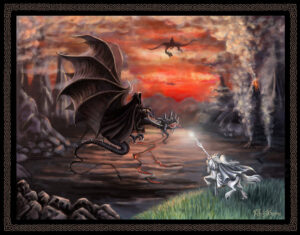
Anyone who has read the Sermon on the Mount knows that Christ is wise. He speaks with incredible authority “You have heard it said of old…But I say unto you…”8 Christ prophesies many things: His own death and Resurrection, the three-fold denial of St. Peter, the destruction of Jerusalem, and more. Christ is the prophet par excellence.
In The Lord of the Rings, Gandalf shoulders the monumental role of prophet. He predicts or foresees many events: the movements of the Enemy, the political intrigues of Rohan and Gondor, and even the impish shenanigans of hobbits. He carries a mysterious, timeless presence about him (read The Silmarillion if you want to know more about where he comes from). To put it bluntly, “he knows stuff.” He is wise, like Daniel. He is irascible, in the way I’ve often imagined the prophet Jeremiah to be irascible. He goes hither and yon bending and shaping events towards the good. And though “even the wise cannot see all ends,” Gandalf sees the big picture, more than any other member of the Fellowship. He is prophet material.
For the past few years, I have signed my emails with the following quote from Gandalf.
Other evils there are that may come…yet it is not our part to master all the tides of the world, but to do what is in us for the succour of those years wherein we are set, uprooting the evil in the fields that we know, so that those who live after may have clean earth to till. What weather they shall have is not ours to rule.9
In another unforgettable passage, a dialogue between Frodo and Gandalf underscores the lofty heights on which the latter operates.
‘But this is terrible!’ cried Frodo. ‘Far worse than the worst that I imagined from your hints and warnings. O Gandalf, best of friends, what am I to do? For now I am really afraid. What am I to do? What a pity that Bilbo did not stab that vile creature [Gollum] when he had a chance!’
‘Pity? It was Pity that stayed his hand. Pity, and Mercy: not to strike without need. And he has been well rewarded, Frodo. Be sure that he took so little hurt from the evil, and escaped in the end, because he began his ownership of the Ring so. With Pity.’
‘I am sorry,’ said Frodo. ‘But I am frightened; and I do not feel any pity for Gollum.’
‘You have not seen him,’ Gandalf broke in.
‘No, and I don’t want to,’ said Frodo. I can’t understand you. Do you mean to say that you, and the Elves, have let him live on after all those horrible deeds? Now at any rate he is as bad as an Orc, and just an enemy. He deserves death.’
‘Deserves it! I daresay he does. Many that live deserve death. And some that die deserve life. Can you give it to them? Then do not be too eager to deal out death in judgement. For even the very wise cannot see all ends. I have not much hope that Gollum can be cured before he dies, but there is a chance of it. And he is bound up with the fate of the Ring. My heart tells me that he has some part to play yet, for good or ill, before the end; and when that comes, the pity of Bilbo may rule the fate of many, yours not least.’10
Aragorn – Christ the King
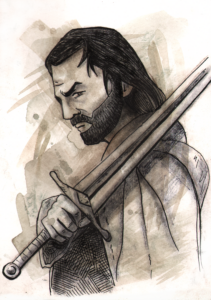
This connection requires the least convincing. Aragorn is a king. Christ is a King. Both kings begin their public lives in hidden obscurity. Neither is born with the proverbial silver spoon in the mouth. Both are repeatedly rejected and insulted by their inferiors, and both take it in stride. Both are kingly on the inside, and common on the outside. Both have moments of “transfiguration,” when the veil hiding their true glory is pulled aside for a moment. For Aragorn, these transfigurations happen multiple times. In certain key moments, he suddenly appears taller, noble, kingly, and terrible, in the best sense of the word. When the hobbits see this for the first time, they are awestruck, much as Peter, James, and John were blown away by the vision on Mt. Tabor.
Aragorn is a just king who abides by his own laws. After his coronation, he decrees that none of the “big folk” are to cross the borders of the Shire (the borders he once protected as a humble Ranger). When the Scouring of the Shire almost destroys the idyllic home of the halflings, Aragorn sees that if this fragile gem is to be preserved in Middle-Earth, it must be vigorously defended. And yet, he does not say goodbye to his hobbit-friends forever. This King of Gondor makes the long journey from his kingdom to the border of the Shire, and from Brandywine Bridge, he speaks with his friend Frodo of days gone by.11
My favorite moment in Aragorn’s reign is his restoration of the White Tree of Gondor. Long story short, the White Tree connects the line of Isiuldur, and the race of men, to the creation of Middle-Earth itself, beyond the mists of time (again, read The Silmarillion for more information). For all intents and purposes, the White Tree represents Tradition in Middle-Earth. And yet, the White Tree in Gondor is dead when Aragorn ascends the throne. Will Aragorn’s line die out? Are old prophecies useless? Is Aragorn a modern man who finds himself alone in a brave new world? No. With the help and guidance of Gandalf, Aragorn personally climbs the slopes of Mindolluin, above Minas Tirith, and there, the two of them find a living sapling of the White Tree. They bring that sapling back to the city, where it takes root, and grows healthy and strong. With the prophet Gandalf, Aragorn the king guides his realm by being firmly rooted in the received Tradition.
All that is gold does not glitter,
Not all those who wander are lost
The old that is strong does not wither,
Deep roots are not reached by the frost.From the ashes a fire shall be woken,
A light from the shadows shall spring;
Renewed shall be blade that was broken,
The crownless again shall be king.12
Conclusion
Why connect the three offices of Christ with the three heroes of The Lord of the Rings? For one, I hope this connection gives you a deeper appreciation for the greatest fantasy novel of all time. I hope it gives you a deeper appreciation for Tolkien himself, a giant among men, a devout Catholic, and a storyteller for the ages. But most of all, I hope this gives you a deeper knowledge and love of Jesus Christ, and His story, which is the greatest story ever told. Standing on the shoulders of J.R.R. Tolkien, I now understand a little more about Christ the High-Priest, Christ the Incarnate Wisdom, and Christ our gracious King.
If we shadows have offended
Think but this, and all is mended.
That you have but slumbered here,
While these visions did appear.13

Fr. Daniel Alloy, FSSP was ordained in 2020. He currently serves as parochial vicar at Regina Caeli Parish in Houston, TX.
- Cf. On Fairy-Stories, by Tolkien.
- Fun fact: these three offices are represented by linen (priesthood), wool (prophecy) and silk (kingship). These are the preferred materials for vestments, albs, and the like.
- Cf. John 18.
- Heb. 5:1.
- Heb. 5:2.
- Tolkien, J.R.R. The Lord of the Rings. New York: HarperCollins (1955). P. 1006.
- Ps. 68:21.
- Cf. Matthew 5.
- Tolkien, 861.
- Ibid., 58.
- Ibid., cf. Appendix B.
- Ibid., 167.
- A Midsummer Night’s Dream, Act V, Scene 1.
March 25, 2025
